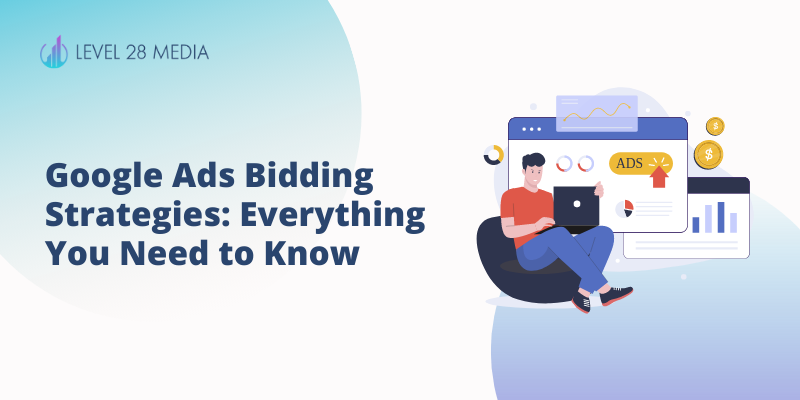When people think of what makes a Google Ads campaign successful, most think about ad copy, keyword selection, and landing page development. However, your Google Ads bidding strategy is just as important.
How much you bid and the bid strategy you select will have a large influence on when your ads will be shown and how much you’ll be paying.
In this article, we’ll go over how bidding works in the Google Ads search network and the different types of bidding strategies.
How Google Ads Bidding Works
Before we dive into bidding strategies, let’s go over how bidding works in Google Ads.
Google is “auctioning” its ad space on its search engine results page and advertisers have to put in a bid in order for an ad to be seen. An auction happens every time a user conducts a search.

However, Google is taking into account more than just your bid price. It will take a look at:
- Max bid price: This is the maximum amount you are willing to pay for someone to click on your ad.
- Ad quality score: Google will analyze your landing page experience and ad copy to estimate your expected click-through rate. As an advertiser, your goal is to get a high quality score for a higher chance of landing the top spot.
- Impact of ad assets: These are assets like sitelinks, call-out extensions, call extensions, and structured snippets.
- Ad Rank: Value that Google uses to determine where your ad is shown on the page compared to competing ads.
- Ad context: Google will look at your ad and how it fits in the context of the searcher’s location, time of search, device, and other signals.
Due to all of these factors, offering the highest bid isn’t always going to get you the highest spot. And this is a good thing! A carefully crafted campaign will end up saving you more money than overspending on clicks and having infinite budget.
Should You Trust Google Ads Smart Bidding?
Smart bidding is a hot topic amongst advertisers in the PPC industry. These are bid strategies that leverage Google’s AI and machine learning to optimize and set bid prices based on your campaign goals. In contrast, manual bidding is where you’ll be setting the bid price for each keyword without Google’s help.
Automation sounds great, doesn’t it? However, you need to proceed with caution when it comes to Smart Bidding.
Depending on your industry’s average CPC and the strategy you choose, Google can actually waste a lot of your budget. Automated strategies may not be the best choice for every business, especially advertisers with smaller, more limited budgets.
You need to make sure specific limits are set to not waste money, but with enough wiggle room to give your campaign time to collect enough data.
If your account structure isn’t too large and it’s organized properly, you should start with manual bidding. Smart Bidding can be a great option for more complex accounts, but you need to keep your risk tolerance in mind. Automated strategies can cause disturbances in your account if you aren’t watching carefully and can take a few weeks to get dialed in.
Types of Google Ads Bid Strategies
Manual CPC Bidding
This is a strategy where you are setting your own maximum CPC for ads – no artificial intelligence involved. Manual CPC offers a lot more control and less budget waste.
If you are a small business, this is the strategy you want to start with and most likely will stick with.
However, manual CPC requires a lot of oversight. You are going into the account and setting the bids one by one for each keyword. If your account has a large number of keywords, you may be better off using an automated strategy.
Target CPA (cost-per-acquisition)
Target CPA is a strategy where you are aiming for a specific CPA number and Google will adjust bids in real-time to meet this goal.
You need to have some conversion data in order for Google to make proper decisions and bid adjustments. It’s recommended to have at least 15 conversions in the last 30 days (per campaign) in order to give this bid strategy enough data to learn.
Many advertisers make the common mistake of setting too low of a target CPA. This will cause your performance to tank because Google can’t meet your CPA requirement, thus limiting your reach.
Make sure you keep your CPA value reasonable and realistic to make Target CPA work.
Maximize Conversions
This strategy is meant to drive the maximum number of conversions given your daily budget. Since it’s a Smart Bidding strategy, this means Google will adjust the bids to hit that maximum number.
Use Maximize Conversions when you have been running your campaign manually for at least 45 days and if you have a larger budget of at least $5,000 per month. Monitor your account like a hawk since Max Conversions can drive up your CPC.
It can even double or triple your average CPC (if you were on manual before) in order to get the max conversions, rustling in you running out of your budget very early on in the month. To combat extremely high CPCs in this automated bid strategy, you can set a bid limit that Google cannot exceed.
Double-check your conversion tracking before implementing this strategy. The last thing you want is to count page views as a conversion.
Maximize Clicks
Maximize Clicks is exactly what it sounds like. Google will adjust your bids to achieve the maximum number of clicks given your daily budget.
This is a great option if you are trying to drive more traffic and click volume, but reconsider this strategy if your CPC is super high. It’s also best to put a max click bid limit in order to not waste money.
Many advertisers with large, enterprise-level accounts and little manpower to implement manual bidding will implement Maximize Click.
Enhanced CPC (eCPC)
eCPC is a “hybrid” type of Google Ads bidding strategy since it combines manual with automated bid adjustments. Google will automatically adjust your manual bids and try to get clicks more likely to lead to a conversion.
If you use this, keep a careful eye on your account since eCPC tends to overinflate bids. This isn’t the most popular strategy with advertisers, but it can be worth trying out.
Target ROAS
This strategy’s goal will be to maximize the return on the advertiser’s desired return on ad spend (ROAS). Google will adjust bids to find the highest number of conversions most likely to generate the highest revenue.
Like several other bid strategies, you can set bid limits to avoid overspending. Keep in mind that this strategy is prone to volatile performance depending on the competitiveness of the keywords or products.
It also relies on accurate conversion tracking, so make sure your account is set up properly to get the best results.
Target Impression Share
Looking for a strategy that is best suited for your brand terms and brand awareness? Target impression share is a great option.
With Target Impression Share, you will set a specific target for your ad’s visibility which can be the absolute top of the page, the top three spots of the page, or anywhere on the page.
If you notice that competitors are trying to take the number one spot for your branded terms, try testing out Target Impression Share. However, proceed with caution since this strategy isn’t the best long-term bidding strategy. It increases your bids to a point that’s unsustainable.
Max conversion value
Max conversion value focuses on maximizing the conversion value to achieve the highest dollar number.
The result? Receiving conversion with a higher revenue figure, but risk of lower returns.
If you do not have clear conversion goals or conversion values set up in Google Ads, this isn’t the strategy for you. For example, brand awareness campaigns should not use max conversion value.
Last Thoughts on Google Ads Bidding Strategies
You are not tied to one singular bidding strategy, but keep your risk tolerance in mind when it comes to Smart Bidding. Your spending can easily get out of hand if you aren’t watching your campaigns closely. Spending can also fluctuate greatly with Smart Bidding.
Make sure to have your campaign set up properly (conversion tracking, campaign structure, ad copy, etc.) because Google takes into account more than just your bid price.
Many advertisers also make the mistake of being too stingy with their ad budget. Having a sizable budget and flexibility will get you the data you need to improve your campaign and in turn, get better results.

Michelle Kop is a marketing consultant and award-winning pay-per-click marketing strategist. She has over 8 years of professional paid advertising experience in Google and Microsoft Ads, with a specialization in lead generation for B2B and B2C companies.
After working in corporate marketing with Fortune Global 500 Brands like Toyota and BP, Michelle founded Level 28 Media, a lead generation micro-agency for small to medium businesses.


